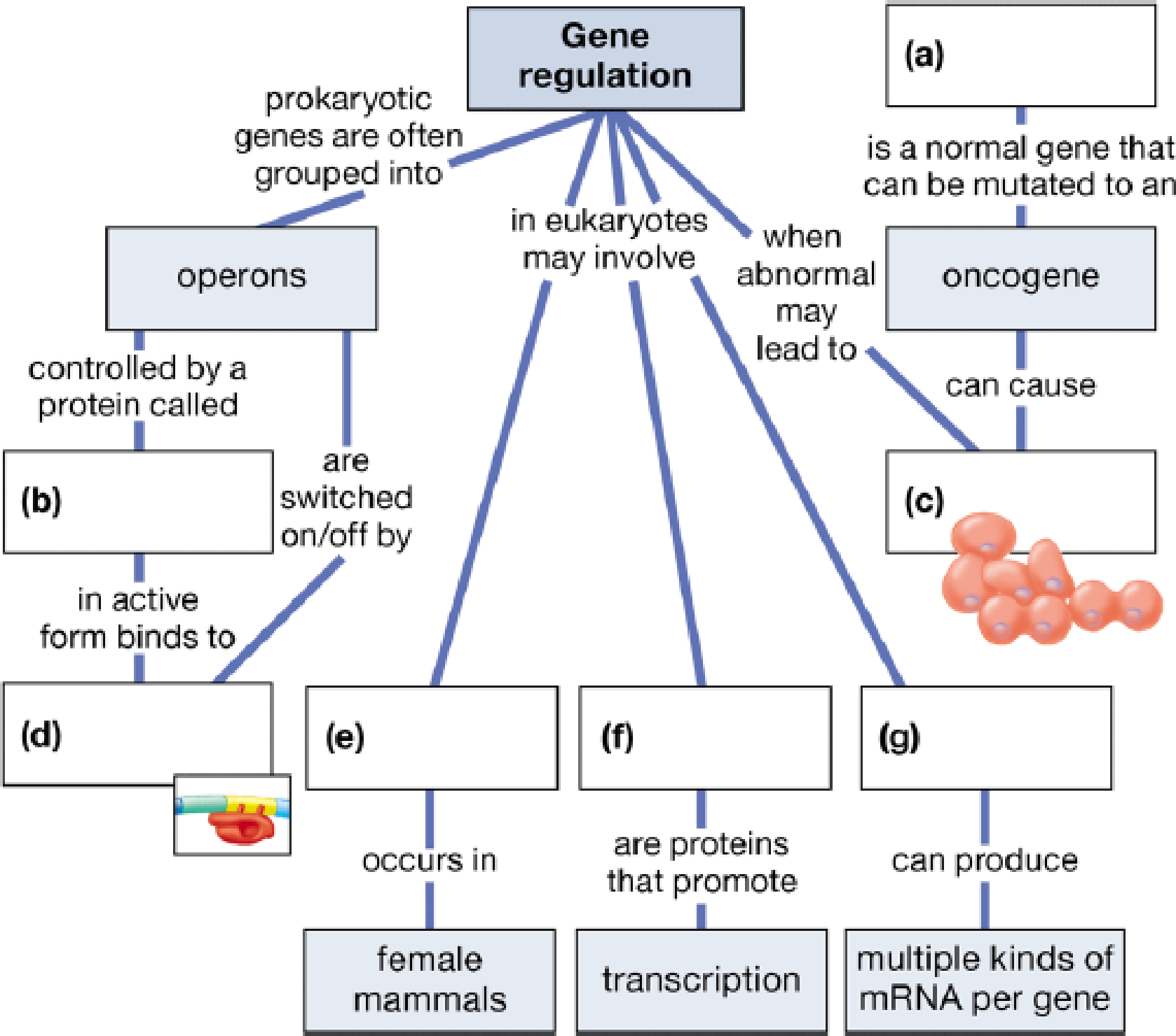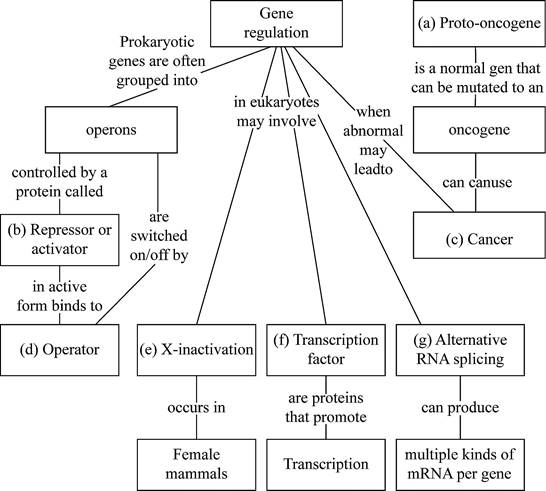
Concept explainers
Complete the following concept map to test your knowledge of gene regulation.

To complete: The given map showing a process of gene regulation.
Introduction: Gene regulation is a process where the expression of genes are controlled for the synthesis of specified gene products (usually RNA or proteins).
Answer to Problem 1CC
Pictorial representation: Figure 1 shows the completed map of the gene regulation in prokaryotes and eukaryotes.

Fig. 1: Gene regulation in prokaryotes and eukaryotes
Explanation of Solution
(a)
Correct answer: Proto-oncogenes.
Explanation: Proto-oncogenes are the common genes which are transformed into oncogenes (malignant genes) during mutation. These mutations can lead to indefinite proliferation of cells.
(b)
Correct answer: Repressor or activator.
Explanation: They are the molecules which regulates the transcription. Activators are transcription factors that activate or boost a gene to express and the repressors are the molecules that stop the expression of a gene.
(c)
Correct answer: Cancer.
Explanation: Cancer is a diseased condition where the normal cells get converted to abnormal cells through undifferentiated and uncontrolled growth.
(d)
Correct answer: Operator.
Explanation: Operator is a part of the operons which regulates the binding of a repressor molecule to it. The transcription is stopped when the repressor binds to the operator, thereby it blocks the further binding of RNA polymerase to initiate the transcription.
(e)
Correct answer: X-inactivation.
Explanation: The process of inactivation of single copy of X chromosomes in female mammals is called as X-inactivation.
(f)
Correct answer: Transcription factors.
Explanation: The proteins that are associated with the transcription of DNA to mRNA are called as transcription.
(g)
Correct answer: Alternative RNA splicing.
Explanation: Alternative splicing (differential splicing) is the process of regulation during a gene expression to produce a single gene which can code for different proteins. Final product of alternative splicing will be a processed mRNA.
Want to see more full solutions like this?
Chapter 11 Solutions
BSC 1005 PKG-W/MOD. MAST. ACCESS >CI<
- Select a diet and give a summary of the main components. Do a web search of the diet and choose one link that provides misinformation. Explain why the site itself and/or the information on the site is not credible. This should be a report. This site should be different from U.S News and World Report. For full credit, you must include the following information and elaborate in detail: The diet name The main components of the diet The misinformation website and link What misinformation is being provided in the other website and how did you determine it was not credible?arrow_forward1. In vivo testing provides valuable insight into a drug’s kinetics. Assessing drug kinetics following multiple different routes of administration provides greater insight than just a single route of administration alone. The following data was collected in 250 g rats following bolus iv, oral (po), and intraperitoneal (ip) administration.Using this data and set of graphs, determine: (a) k, C0, V, and AUC* for the bolus iv data (b) k, ka, B1, and AUC* for the po data (c) k, ka, B1, and AUC* for the ip data (d) relative bioavailability for po vs ip, Fpo/Fip (e) absolute po bioavailability, (f)Fpo absolute ip bioavailability, Fip MAKE SURE ANSWERS HAVE UNITS if appropriate. SHOW ALL WORK, including equation used, variables used and each step to your solution.arrow_forward2. Drug quantification from plasma is commonly performed by using techniques such as HPLC or LC/MS. However, these methods do have limitations, and investigators may choose to use a radiolabeled analog of a drug instead. Radioligands are molecules that contain radioactive isotopes, commonly 3H or 14C. This technique allows investigators to quantify drug concentration from radiation measurements. The following measurements were made in 250 g rats following oral administration of 18.2 µCi of a 14C-labeled drug of interest: Time (min) Plasma Radiation Levels (µCi/L) 0 0.0 2 9.7 4 19.2 7 25.3 9 37.8 12 39.6 14 45.8 17 48.8 20 52.0 25 56.4 30 59.2 35 60.1 40 61.1 45 62.1 50 62.8 60 63.1 70 62.1 80 60.1 90 57.3 100 55.5 110 53.7 120 52.2 150 48.0 180 45.0 240 39.0 Note that a µCi is a measure of the amount of radioactivity and hence is a measure of the amount of drug present. Given that the oral bioavailability of this drug is known to be essentially 100%, estimate the following from this…arrow_forward
- The current nutrition labelling regulation in Hong Kong requires food manufacturer to list E+7 information on the package of pre-packaged food products. Do you think that more nutrients, such as calcium and cholesterol, shall be included?arrow_forwardView History Bookmarks Window Help Quarter cements ents ons (17) YouTube Which amino acids would you expect to find marked on the alpha helix? canvas.ucsc.edu ucsc Complaint and Grievance Process - Academic Personnel pach orations | | | | | | | | | | | | | | | | 000000 000000000 | | | | | | | | | | | | | | | | | | | | | | 00000000 scope vious De 48 12.415 KATPM FEB 3 F1 F2 80 F3 a F4 F5 2 # 3 $ 85 % tv N A の Mon Feb 3 10:24 PM Lipid bilayer Submit Assignment Next > ZOOM < Å DII 8 བ བ F6 16 F7 F8 F9 F10 34 F11 F12 & * ( 6 7 8 9 0 + 11 WERTY U { 0 } P deletearrow_forwardDifferent species or organisms research for ecologyarrow_forward
- What is the result of the following gram stain: positive ○ capsulated ○ acid-fast ○ negativearrow_forwardWhat type of stain is the image below: capsule stain endospore stain gram stain negative stain ASM MicrobeLibrary.org Keplingerarrow_forwardWhat is the result of the acid-fast stain below: Stock Images by Getty Images by Getty Images by Getty Images by Getty Image Getty Images St Soy Getty Images by Getty Images by Getty Images Joy Getty encapsulated O endosporulating negative ○ positivearrow_forward
- You have a stock vial of diligence 75mg in 3ml and need to draw up a dose of 50mg for your patient.how many mls should you draw up to give this dosearrow_forwardYou are recquired to administer 150mg hydrocortisone intravenously,how many mls should you give?(stock =hydrocortisone 100mg in 2mls)arrow_forwardIf someone was working with a 50 MBq F-18 source, what would be the internal and external dose consequences?arrow_forward

 Human Heredity: Principles and Issues (MindTap Co...BiologyISBN:9781305251052Author:Michael CummingsPublisher:Cengage Learning
Human Heredity: Principles and Issues (MindTap Co...BiologyISBN:9781305251052Author:Michael CummingsPublisher:Cengage Learning Biology (MindTap Course List)BiologyISBN:9781337392938Author:Eldra Solomon, Charles Martin, Diana W. Martin, Linda R. BergPublisher:Cengage Learning
Biology (MindTap Course List)BiologyISBN:9781337392938Author:Eldra Solomon, Charles Martin, Diana W. Martin, Linda R. BergPublisher:Cengage Learning Concepts of BiologyBiologyISBN:9781938168116Author:Samantha Fowler, Rebecca Roush, James WisePublisher:OpenStax College
Concepts of BiologyBiologyISBN:9781938168116Author:Samantha Fowler, Rebecca Roush, James WisePublisher:OpenStax College Human Biology (MindTap Course List)BiologyISBN:9781305112100Author:Cecie Starr, Beverly McMillanPublisher:Cengage Learning
Human Biology (MindTap Course List)BiologyISBN:9781305112100Author:Cecie Starr, Beverly McMillanPublisher:Cengage Learning Biology: The Dynamic Science (MindTap Course List)BiologyISBN:9781305389892Author:Peter J. Russell, Paul E. Hertz, Beverly McMillanPublisher:Cengage Learning
Biology: The Dynamic Science (MindTap Course List)BiologyISBN:9781305389892Author:Peter J. Russell, Paul E. Hertz, Beverly McMillanPublisher:Cengage Learning





